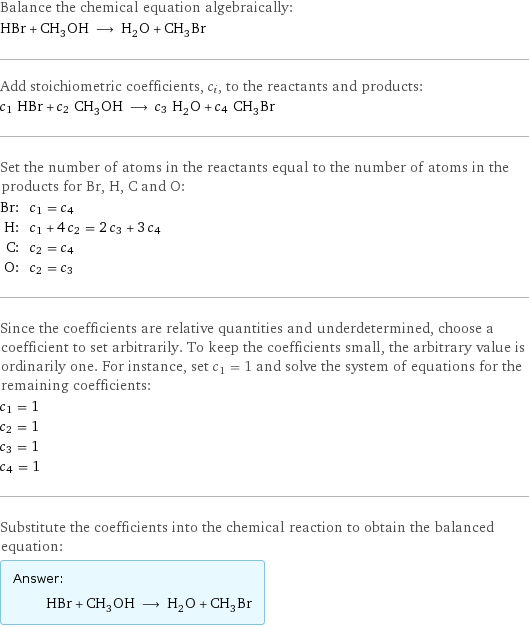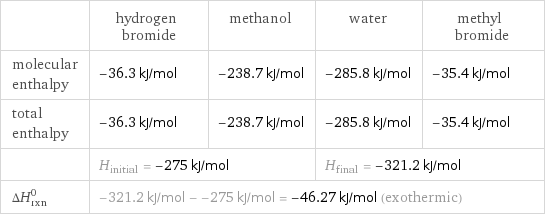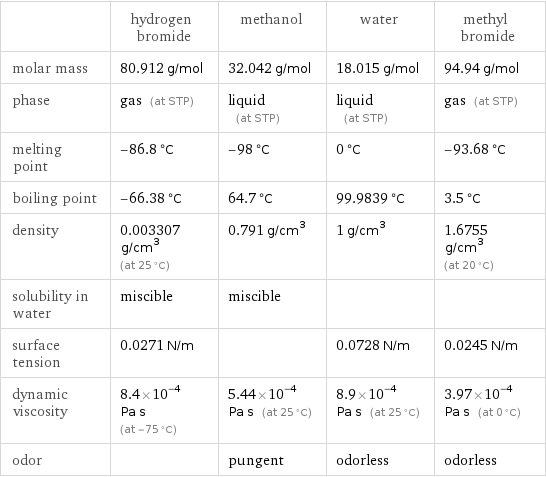Input interpretation

HBr hydrogen bromide + CH_3OH methanol ⟶ H_2O water + CH_3Br methyl bromide
Balanced equation

Balance the chemical equation algebraically: HBr + CH_3OH ⟶ H_2O + CH_3Br Add stoichiometric coefficients, c_i, to the reactants and products: c_1 HBr + c_2 CH_3OH ⟶ c_3 H_2O + c_4 CH_3Br Set the number of atoms in the reactants equal to the number of atoms in the products for Br, H, C and O: Br: | c_1 = c_4 H: | c_1 + 4 c_2 = 2 c_3 + 3 c_4 C: | c_2 = c_4 O: | c_2 = c_3 Since the coefficients are relative quantities and underdetermined, choose a coefficient to set arbitrarily. To keep the coefficients small, the arbitrary value is ordinarily one. For instance, set c_1 = 1 and solve the system of equations for the remaining coefficients: c_1 = 1 c_2 = 1 c_3 = 1 c_4 = 1 Substitute the coefficients into the chemical reaction to obtain the balanced equation: Answer: | | HBr + CH_3OH ⟶ H_2O + CH_3Br
Structures

+ ⟶ +
Names

hydrogen bromide + methanol ⟶ water + methyl bromide
Reaction thermodynamics
Enthalpy

| hydrogen bromide | methanol | water | methyl bromide molecular enthalpy | -36.3 kJ/mol | -238.7 kJ/mol | -285.8 kJ/mol | -35.4 kJ/mol total enthalpy | -36.3 kJ/mol | -238.7 kJ/mol | -285.8 kJ/mol | -35.4 kJ/mol | H_initial = -275 kJ/mol | | H_final = -321.2 kJ/mol | ΔH_rxn^0 | -321.2 kJ/mol - -275 kJ/mol = -46.27 kJ/mol (exothermic) | | |
Equilibrium constant
![Construct the equilibrium constant, K, expression for: HBr + CH_3OH ⟶ H_2O + CH_3Br Plan: • Balance the chemical equation. • Determine the stoichiometric numbers. • Assemble the activity expression for each chemical species. • Use the activity expressions to build the equilibrium constant expression. Write the balanced chemical equation: HBr + CH_3OH ⟶ H_2O + CH_3Br Assign stoichiometric numbers, ν_i, using the stoichiometric coefficients, c_i, from the balanced chemical equation in the following manner: ν_i = -c_i for reactants and ν_i = c_i for products: chemical species | c_i | ν_i HBr | 1 | -1 CH_3OH | 1 | -1 H_2O | 1 | 1 CH_3Br | 1 | 1 Assemble the activity expressions accounting for the state of matter and ν_i: chemical species | c_i | ν_i | activity expression HBr | 1 | -1 | ([HBr])^(-1) CH_3OH | 1 | -1 | ([CH3OH])^(-1) H_2O | 1 | 1 | [H2O] CH_3Br | 1 | 1 | [CH3Br] The equilibrium constant symbol in the concentration basis is: K_c Mulitply the activity expressions to arrive at the K_c expression: Answer: | | K_c = ([HBr])^(-1) ([CH3OH])^(-1) [H2O] [CH3Br] = ([H2O] [CH3Br])/([HBr] [CH3OH])](../image_source/2456104718148d8f8c67021741830c26.png)
Construct the equilibrium constant, K, expression for: HBr + CH_3OH ⟶ H_2O + CH_3Br Plan: • Balance the chemical equation. • Determine the stoichiometric numbers. • Assemble the activity expression for each chemical species. • Use the activity expressions to build the equilibrium constant expression. Write the balanced chemical equation: HBr + CH_3OH ⟶ H_2O + CH_3Br Assign stoichiometric numbers, ν_i, using the stoichiometric coefficients, c_i, from the balanced chemical equation in the following manner: ν_i = -c_i for reactants and ν_i = c_i for products: chemical species | c_i | ν_i HBr | 1 | -1 CH_3OH | 1 | -1 H_2O | 1 | 1 CH_3Br | 1 | 1 Assemble the activity expressions accounting for the state of matter and ν_i: chemical species | c_i | ν_i | activity expression HBr | 1 | -1 | ([HBr])^(-1) CH_3OH | 1 | -1 | ([CH3OH])^(-1) H_2O | 1 | 1 | [H2O] CH_3Br | 1 | 1 | [CH3Br] The equilibrium constant symbol in the concentration basis is: K_c Mulitply the activity expressions to arrive at the K_c expression: Answer: | | K_c = ([HBr])^(-1) ([CH3OH])^(-1) [H2O] [CH3Br] = ([H2O] [CH3Br])/([HBr] [CH3OH])
Rate of reaction
![Construct the rate of reaction expression for: HBr + CH_3OH ⟶ H_2O + CH_3Br Plan: • Balance the chemical equation. • Determine the stoichiometric numbers. • Assemble the rate term for each chemical species. • Write the rate of reaction expression. Write the balanced chemical equation: HBr + CH_3OH ⟶ H_2O + CH_3Br Assign stoichiometric numbers, ν_i, using the stoichiometric coefficients, c_i, from the balanced chemical equation in the following manner: ν_i = -c_i for reactants and ν_i = c_i for products: chemical species | c_i | ν_i HBr | 1 | -1 CH_3OH | 1 | -1 H_2O | 1 | 1 CH_3Br | 1 | 1 The rate term for each chemical species, B_i, is 1/ν_i(Δ[B_i])/(Δt) where [B_i] is the amount concentration and t is time: chemical species | c_i | ν_i | rate term HBr | 1 | -1 | -(Δ[HBr])/(Δt) CH_3OH | 1 | -1 | -(Δ[CH3OH])/(Δt) H_2O | 1 | 1 | (Δ[H2O])/(Δt) CH_3Br | 1 | 1 | (Δ[CH3Br])/(Δt) (for infinitesimal rate of change, replace Δ with d) Set the rate terms equal to each other to arrive at the rate expression: Answer: | | rate = -(Δ[HBr])/(Δt) = -(Δ[CH3OH])/(Δt) = (Δ[H2O])/(Δt) = (Δ[CH3Br])/(Δt) (assuming constant volume and no accumulation of intermediates or side products)](../image_source/f528dd4ed644f54877d03fdd0715690c.png)
Construct the rate of reaction expression for: HBr + CH_3OH ⟶ H_2O + CH_3Br Plan: • Balance the chemical equation. • Determine the stoichiometric numbers. • Assemble the rate term for each chemical species. • Write the rate of reaction expression. Write the balanced chemical equation: HBr + CH_3OH ⟶ H_2O + CH_3Br Assign stoichiometric numbers, ν_i, using the stoichiometric coefficients, c_i, from the balanced chemical equation in the following manner: ν_i = -c_i for reactants and ν_i = c_i for products: chemical species | c_i | ν_i HBr | 1 | -1 CH_3OH | 1 | -1 H_2O | 1 | 1 CH_3Br | 1 | 1 The rate term for each chemical species, B_i, is 1/ν_i(Δ[B_i])/(Δt) where [B_i] is the amount concentration and t is time: chemical species | c_i | ν_i | rate term HBr | 1 | -1 | -(Δ[HBr])/(Δt) CH_3OH | 1 | -1 | -(Δ[CH3OH])/(Δt) H_2O | 1 | 1 | (Δ[H2O])/(Δt) CH_3Br | 1 | 1 | (Δ[CH3Br])/(Δt) (for infinitesimal rate of change, replace Δ with d) Set the rate terms equal to each other to arrive at the rate expression: Answer: | | rate = -(Δ[HBr])/(Δt) = -(Δ[CH3OH])/(Δt) = (Δ[H2O])/(Δt) = (Δ[CH3Br])/(Δt) (assuming constant volume and no accumulation of intermediates or side products)
Chemical names and formulas

| hydrogen bromide | methanol | water | methyl bromide formula | HBr | CH_3OH | H_2O | CH_3Br Hill formula | BrH | CH_4O | H_2O | CH_3Br name | hydrogen bromide | methanol | water | methyl bromide IUPAC name | hydrogen bromide | methanol | water | bromomethane
Substance properties

| hydrogen bromide | methanol | water | methyl bromide molar mass | 80.912 g/mol | 32.042 g/mol | 18.015 g/mol | 94.94 g/mol phase | gas (at STP) | liquid (at STP) | liquid (at STP) | gas (at STP) melting point | -86.8 °C | -98 °C | 0 °C | -93.68 °C boiling point | -66.38 °C | 64.7 °C | 99.9839 °C | 3.5 °C density | 0.003307 g/cm^3 (at 25 °C) | 0.791 g/cm^3 | 1 g/cm^3 | 1.6755 g/cm^3 (at 20 °C) solubility in water | miscible | miscible | | surface tension | 0.0271 N/m | | 0.0728 N/m | 0.0245 N/m dynamic viscosity | 8.4×10^-4 Pa s (at -75 °C) | 5.44×10^-4 Pa s (at 25 °C) | 8.9×10^-4 Pa s (at 25 °C) | 3.97×10^-4 Pa s (at 0 °C) odor | | pungent | odorless | odorless
Units
